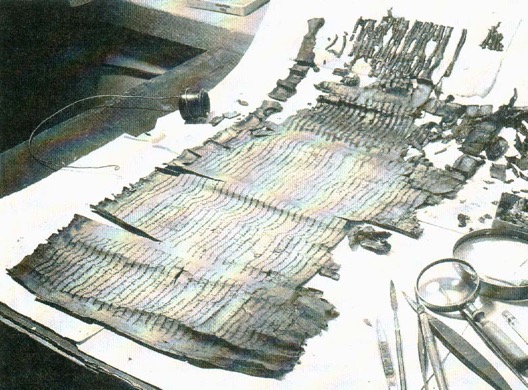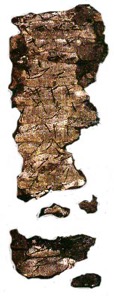In 1985 Gabriel Barkay, a Jewish archeologist, was conducting a dig in a series of caves in the Hinnom Valley, close to Jerusalem when he discovered a collection of ancient artifacts. One particular decorated artefact attracted his attention. On examining it he realized he had found an ancient necklace of great importance. The necklace was made of precious metal but even more precious was what was attached to the necklace. From the chain of the necklace hung a silver scroll. Those who were on the team with Barkay when he found the necklace were busting themselves to open the silver scroll and read the words inscribed on it. In the first photo you can see the painstaking process involved in opening an ancient scroll. It doesn’t happen without great care and patience. The scroll in the photograph is an 8th Century velum scroll which has been made brittle with time. To open it suddenly and without care would reduce it to dust.

To open a velum scroll and preserve the contents, it first has to be softened by chemicals and opened milimetre by milimetre. Between each infinitesimal step more softening takes place. That process continues until finally the scroll is completely unrolled. You can see with the veulm scroll the portion that has been tightly bound in the centre has broken into smaller fragments. The scroll in the second photo is the silver scroll found by Barkay in 1985. The opening process is much the same as that of the 8th Century velum scroll. Great care went into opening such a delicate ancient object. Despite that fact, the white portions in the photo represent the places where the silver scroll turned to powder.


Note that there was only one large contiguous segment left intact, but nevertheless the silver scroll is still perfectly readable. Written on the scroll is a very familiar portion of the Old Testament. It is the kind of reading that one would expect a Jewish person might wear around their neck.
יברכך יהוה וישׁמרך׃
יאר יהוה פניו אליך ויחנך׃
ישׂא יהוה פניו אליך וישׂם לך שׁלום׃
Not one letter of the text has changed in all of that time. However that is impossible for most of us to tell. Most of us don’t have the technology to decipher the markings on the scroll and neither can we read Hebrew. To read it we need a translation.
‘May the LORD bless you and protect you.
May the LORD smile on you and be gracious to you.
May the LORD show you his favour and give you his peace.’
I can assure you that the text of these three verses has been faithfully recorded down through the ages so that not one jot or tittle has been lost through all of that time. This silver scroll represents the oldest written text of a part of the Old Testament in existence. It is dated 700 years before the Qumran Scrolls to approximately 700 BC.
